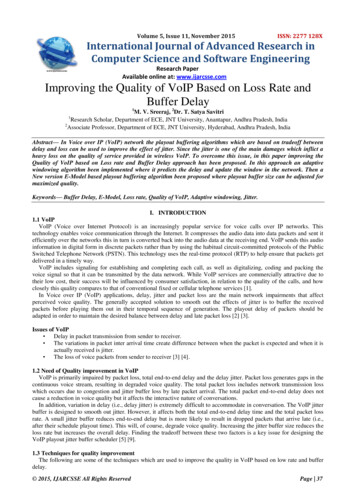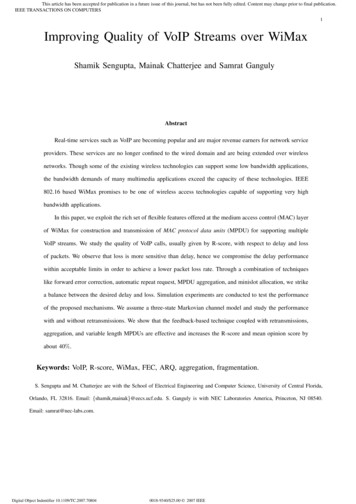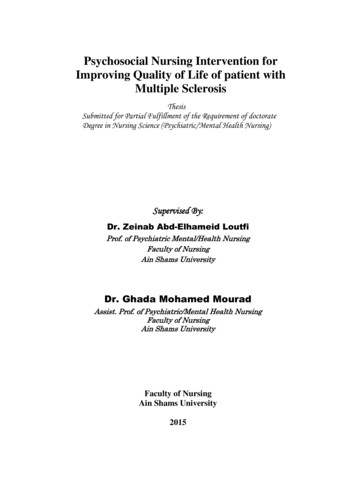
Transcription
Volume 5, Issue 11, November 2015ISSN: 2277 128XInternational Journal of Advanced Research inComputer Science and Software EngineeringResearch PaperAvailable online at: www.ijarcsse.comImproving the Quality of VoIP Based on Loss Rate andBuffer Delay1M. V. Sreeraj, 2Dr. T. Satya SavitriResearch Scholar, Department of ECE, JNT University, Anantapur, Andhra Pradesh, India2Associate Professor, Department of ECE, JNT University, Hyderabad, Andhra Pradesh, India1Abstract— In Voice over IP (VoIP) network the playout buffering algorithms which are based on tradeoff betweendelay and loss can be used to improve the effect of jitter. Since the jitter is one of the main damages which inflict aheavy loss on the quality of service provided in wireless VoIP. To overcome this issue, in this paper improving theQuality of VoIP based on Loss rate and Buffer Delay approach has been proposed. In this approach an adaptivewindowing algorithm been implemented where it predicts the delay and update the window in the network. Then aNew version E-Model based playout buffering algorithm been proposed where playout buffer size can be adjusted formaximized quality.Keywords— Buffer Delay, E-Model, Loss rate, Quality of VoIP, Adaptive windowing, Jitter.I. INTRODUCTION1.1 VoIPVoIP (Voice over Internet Protocol) is an increasingly popular service for voice calls over IP networks. Thistechnology enables voice communication through the Internet. It compresses the audio data into data packets and sent itefficiently over the networks this in turn is converted back into the audio data at the receiving end. VoIP sends this audioinformation in digital form in discrete packets rather than by using the habitual circuit-committed protocols of the PublicSwitched Telephone Network (PSTN). This technology uses the real-time protocol (RTP) to help ensure that packets getdelivered in a timely way.VoIP includes signaling for establishing and completing each call, as well as digitalizing, coding and packing thevoice signal so that it can be transmitted by the data network. While VoIP services are commercially attractive due totheir low cost, their success will be influenced by consumer satisfaction, in relation to the quality of the calls, and howclosely this quality compares to that of conventional fixed or cellular telephone services [1].In Voice over IP (VoIP) applications, delay, jitter and packet loss are the main network impairments that affectperceived voice quality. The generally accepted solution to smooth out the effects of jitter is to buffer the receivedpackets before playing them out in their temporal sequence of generation. The playout delay of packets should beadapted in order to maintain the desired balance between delay and late packet loss [2] [3].Issues of VoIP Delay in packet transmission from sender to receiver. The variations in packet inter arrival time create difference between when the packet is expected and when it isactually received is jitter. The loss of voice packets from sender to receiver [3] [4].1.2 Need of Quality improvement in VoIPVoIP is primarily impaired by packet loss, total end-to-end delay and the delay jitter. Packet loss generates gaps in thecontinuous voice stream, resulting in degraded voice quality. The total packet loss includes network transmission losswhich occurs due to congestion and jitter buffer loss by late packet arrival. The total packet end-to-end delay does notcause a reduction in voice quality but it affects the interactive nature of conversations.In addition, variation in delay (i.e., delay jitter) is extremely difficult to accommodate in conversation. The VoIP jitterbuffer is designed to smooth out jitter. However, it affects both the total end-to-end delay time and the total packet lossrate. A small jitter buffer reduces end-to-end delay but is more likely to result in dropped packets that arrive late (i.e.,after their schedule playout time). This will, of course, degrade voice quality. Increasing the jitter buffer size reduces theloss rate but increases the overall delay. Finding the tradeoff between these two factors is a key issue for designing theVoIP playout jitter buffer scheduler [5] [9].1.3 Techniques for quality improvementThe following are some of the techniques which are used to improve the quality in VoIP based on low rate and bufferdelay. 2015, IJARCSSE All Rights ReservedPage 37
Sreeraj et al., International Journal of Advanced Research in Computer Science and Software Engineering 5(11),November- 2015, pp. 37-43 Adaptive Jitter Buffer Play-Out scheme MOS-Based Rate Adaption Speech Playout Buffering Algorithm Adaptive Jitter Buffer Adaptive Variable-Size Window1.4 Problem identificationIn our previous paper “SCTP and FEC based Loss Recovery Technique for VoIP” is proposed. In this the data packetswhich were not affected is chosen by the FEC, and they are transmitted through SCTP. While transmission FEC isexecuted at every intermediate node to check packet lose. The packet loss estimator gets executed after the data packetsreach the receiver endpoint and the retransmission of the lost packets request is given to the sender.II. LITERATURE REVIEWLing fen Sun and Emmanuel C. Ifeachor [3] have presented a new methodology for developing models fornonintrusive prediction of voice quality. They have developed nonlinear regression models to predict perceived voicequality nonintrusive for four modern codec’s (i.e., G.729, G.723.1, AMR, and iLBC). The method exploits the intrusivealgorithm, PESQ, and a combined PESQ/E-model structure to provide a perceptually accurate prediction of voice qualitynonintrusive, which avoids time-consuming subjective tests. Also they further applied the regression models to two mainapplications: voice quality prediction for real Internet VoIP traces and perceived quality-driven playout bufferoptimization. For playout buffer optimization, the proposed perceptual optimized playout buffer algorithm also achievedoptimum voice quality when compared to five other buffer algorithms for all the traces considered. However, significantnumbers of spikes are accompanied by a gradual increase which cannot be detected by the above algorithm.Marian VRABEL and Martin KLIMO [4] have presented the method for improving VoIP QoS. Here the algorithm forjitter buffer control is presented. This algorithm inserts and deletes segments of silence and periods of vowels. After thetests, the results are analyzed and compared to the reference jitter buffer. However for higher jitters, the quality of nonadaptive implementations is no longer satisfying.T. H. Szymanski [5] has proposed a Guaranteed-Rate scheduling algorithm for packet-switched IP routers with rate,delay and jitter guarantees. The algorithm can be used to schedule traffic with 100% throughput in Input-Queued IProuters with unity speedup. The traffic is scheduled according to transmission frames of duration F time-slots. Therecursive fair stochastic matrix decomposition is based upon the routing of a permutation through a binary rearrangecapable network. The delay and delay jitter experienced along an end-to-end path in a packet-switched IP/MPLS networkare therefore small and bounded by an integer number of IIDTs, and the buffer sizes within the IP routers are small andbounded. The proposed algorithm can be used to schedule Guaranteed-Rate traffic and to provide near-optimal queuingdelays and essentially-zero delay jitter along end-to-end paths when playback buffers are employed. However a smallbuffer may cause significant losses, instability or performance degradation at the application layer.Hyewon Lee et al [6] have designed two novel features for the rate adaptation of VoWLANs. Fast decrease (FD)guides the PHY rates of retransmission frames to low PHY rates so that those frames can be successfully deliveredbefore the retry counter expires. Retry scheduling (RS) manages the timing for the retransmissions in order to avoid bothdeep channel fading and hidden terminal interference. The proposed novel features improve the QoS of VoWLAN.However there occurs packet loss in the system.Manjari Chhawchharia and Atanu Guchhait [7] have presented a mechanism for improving VoIP capacity in802.11b/g networks. Using Virtual Contention-Free Channel Access (VCFCA) the underlying drawbacks of standardbased DCF scheme is overcome. The proposed technique uses traffic aggregation in the downlink with a contention-freechannel access mechanism in the uplink transmission. This methodology minimizes the effect of the identified drawbacksof the existing baseline model, thereby resulting in more efficient bandwidth utilization. However in the proposedmechanism the station remains idle for a long period during VCFCA.Rongwei Yu et al [8] have proposed a new quality-based jitter buffer algorithm. An adaptive windowing algorithm isintroduced to dynamically adjust the window size which indicates the numbers of packets used to estimate the futurenetwork delay and loss rate. In conclusion, E-Model is applied to evaluate the speech quality based on delay histogram.By searching for the maximum speech quality, the optimal buffer delay is obtained. The whole VoIP communicationunder our proposed algorithm not only suffers the smallest average delay and lowest packet loss, but also achieves thehighest speech quality. However a time-scale modification technique is required.III. PROBLEM IDENTIFICATION AND SOLUTION3.1 OverviewIn the extension work after the transmission of packets and estimating the packet loss rate, the VoIP quality willbe evaluated based on the estimated buffer delay and loss rate.For predicting the buffer delay adaptive windowing algorithm [8] can be used for updating, which in turn estimatesthe buffer delay. Here while transmitting the data packets the receiver end uses this variable window size algorithm forupdating the window size. By this the future network delay is estimated. The accuracy of the network is improved withthis by estimating the buffer delay.And for estimating the loss rate, NEM (New version E-Model based playout buffering algorithm) [2] can be used. Inthis algorithm, based on the estimated loss and delay of the previous packets, the playout buffer size can be adjusted for 2015, IJARCSSE All Rights ReservedPage 38
Sreeraj et al., International Journal of Advanced Research in Computer Science and Software Engineering 5(11),November- 2015, pp. 37-43maximizing the estimated conversational quality during the future conversional unit. By estimating loss and delay,conversational quality is determined. This can achieve a finest perceived speech quality, and reduced bursty loss.3.2 Adaptive Windowing AlgorithmAn adaptive windowing algorithm with the help of sliding window whose size can be immediately recomputed onlinebased on rate of change examined from data in the window. This process helps the window to detect and adapt certainlyto the distribution change and concept drift. Once the algorithm is finished, it come with reliable conclusion that there isno change inside the updated window. The ADWIN then provides with exact assurance of false positives and falsenegatives based on only one parameter that is a confidence bound δ, which confidence level of algorithm’s output.The main idea behind this algorithm is very simple and easy. The data which are produced based on distributionfunction which are divided into two sub windows will have a same observed average. If there is enough differencebetween two sub windows then it indicates that there is a change in these windows. In other way it can be said that anolder fragment of other window will drop only in case if there is enough proof that its average value is distinct from therest of the window. It simply checks the condition that whether the observed average in both sub windows are variesmore than the threshold cut which considers the value , length of the considered sub windows and so on.1.2.Initialize Window U.U U {xt };3.While ( vuo-vu1 cut }4.5.Drop elements from tail of USplit of U in to U U 0 .U 1 ;6.Recount vuo, vu1 , cut ;7.8.End whileOutput updated window U.To make mechanism more valuable, a time efficient and memory-efficient version ADWIN 2 is proposed. Thisversion keeps a window of length with the help of O (log ) instead of using O ( ) and checks only O (log ) cutpoints. This advancement on time and memory influences its application to the proposed jitter buffer algorithm.ADWIN act as a change detector to detect the status of current network change. The window size which representsnumber of historical statistical is recomputed online based on rate of delay change detected from the window itself. Thewindow will then grow certainly if the network is stationary and will fall automatically and rapidly to discard old packetsthwart is taking place. For each and every packets perform the following steps:1. If packet p is first packet of a talk spurt, then play out delay of packet p depends on network delay and algorithmgoes to step 8.2. Call Adaptive windowing Algorithm in order to update window size 3. Make use of voice packets in window to get the estimated delay distribution based upon histogram method.4. Calculate the packet loss rate based on delay distribution.5. Then, calculate speech quality based on E-Model. After performing this, MOS value contains an independentvariable i.e. network delay.6. After that investigate about the optimal playout time with maximum MOS.7. Set playout delay of this packet to the optimal time found in step 6.8. End the algorithm3.3 New version E-ModelThis section describes about the proposed playout buffering algorithm called as NEM (New version E-Model basedplayout buffering algorithm). The main idea behind this proposed algorithm depends on the statistics related to loss anddelay of the previous packets, even on the playout buffer size which is set to maximize the expected conversationalquality at the time of future conversional unit.For the proposed algorithm, the basic delay and any other transmission damages are considered with the help of EModel. This is a type of computational model which make use of various parameters in order to calculate the quality ofpacket. The result which is obtained by the E-model provides with transmission rating factor R. This transmission ratingfactor helps to combine all different kind of transmission which are related to the considered connection, for e.g. codec,echo etc. This rating factor consists of following parameter:R 93.2 I d Pfr(1)Where,R is the all kinds of transmission impairments, Id represents the impairments only due to network delay, and P fr is theprobability of packet loss (considered from the previous paper sec 3.4)I d 0.024(d ) 0.11(d 177.3) H (d 177.3) (2)Where the H(x) is step function, 2015, IJARCSSE All Rights ReservedPage 39
Sreeraj et al., International Journal of Advanced Research in Computer Science and Software Engineering 5(11),November- 2015, pp. 37-43 0, x 0H ( x) (3) 1, x 0Pfr is the probability of packet loss which has been estimated in the previous. Through this P fr we find the R in theabove equation (1)p fr 1 Fd (d in D i )(4)Where𝐹′𝑑 is the cumulative function of the retransmission packet delay, which also follows a pareto distribution. D’ i is theestimated local optimal buffer delay which can tolerate retransmission delay and 𝑑𝑖𝑛 is the mean delay.As it is already defined that the conversational quality is established based on loss and delay, and loss is decided basedon delay, the conversational quality represents the function of delay. Hence MOS value is used in terms of end to enddelay in order to estimate the conversational quality in the playout buffering algorithm. The advantage of bufferadjustment between talk spurts is that it produces a smoother playout with respect to constantly revising the method. Thistechnique is adopted in the proposed algorithm where the buffer is modified based on maximizing the expected futuretransmission quality during conversational pauses.Fig 1: NEM algorithmIn the flowchart consider i 1 .) index the talk spurts and (j 1 .) index the packets at the time of the VolP session.Let Mi(de2e) denote the E-Model quality function which has been converted to MOS-scale for talkspurt It reflects theobserved speech quality in talk spurt i.I.eff .i(de2 and I d,i(de2e) represents the loss impairment and delay impairmentduring talkspurt respectively which are mainly used to get the prediction of function Mi(de2e). The proposed NEMstrategy is described as follows(1) First set the end-to-end delay of the first talk spurt.(2) After that revise the history window after receiving a new packet. However calculate the value of Burst R onlyat the beginning of a new talkspurt.(3) At the beginning of a new talkspurt (i.e. talkspurt i), (Burst R) is used, I e.effi, Id,i(d2e2) which is based on thehistory window to build the function Mi (de2e) using equation.(4) Find the optimal setting of the end-to-end delay dOPt,i for talkspurt which is defined asdopt,i : M i (dopt,i ) max M i ( x)x R(5)IV. SIMULATION RESULTS4.1 Simulation Model and ParametersThis section deals with the experimental performance evaluation of our algorithm through simulations. In order to testour technique, NS-2 simulator [10] is used. NS2 is a general-purpose simulation tool that provides discrete eventsimulation of user defined networks.We have used the BitTorrent packet-level simulator for P2P networks [ ]. A network topology is only used for thepacket-level simulator. Based on the assumption that the bottleneck of the network is at the access links of the users andnot at the routers, we use a simplified topology in our simulations. We model the network with the help of access andoverlay links. Each peer is connected with an asymmetric link to its access router. All access routers are connecteddirectly to each other modeling only an overlay link. This enables us to simulate different upload and downloadcapacities as well as different end-to-end (e2e) delays between different peers.In the simulation, 11 nodes are used for 30 seconds of simulation time. The simulated traffic is SCTP. The topology isshown in the following figure. 2015, IJARCSSE All Rights ReservedPage 40
Sreeraj et al., International Journal of Advanced Research in Computer Science and Software Engineering 5(11),November- 2015, pp. 37-43Fig 2 Simulation TopologyThe simulation settings and parameters are summarized in table.No. of Nodes11Simulation Time30 secTraffic TypeSCTPPacket Size512Chunk Size250,500,750,1000KbError Rate0.1,0.2,0.3,0.4 and 0.54.2 Performance MetricsThe proposed SCTPFECLB technique is compared with the standard SCTP technique. The performance is evaluatedmainly, according to the following metrics. Packet Delivery Ratio: It is the ratio between the number of packets received and the number of packets sent. Packet Drop: It refers the average number of packets dropped during the transmission Throughput: It is the total number of packets received by the receiver.A. Based on Chunk SizeIn our first experiment we vary the chunk size as 250,500,750 and 1000Kb.DeliveryRatioChunkSize Vs 2505007501000ChunkSizeFig 3: Chunk Size Vs Delivery RatioPktsChunkSize Vs 0ChunkSizeFig 4: Chunk Size Vs DropThroughputChunkSize Vs unkSizeFig 5: Chunk Size Vs Throughput 2015, IJARCSSE All Rights ReservedPage 41
Sreeraj et al., International Journal of Advanced Research in Computer Science and Software Engineering 5(11),November- 2015, pp. 37-43Figure 3 shows the delivery ratio of SCTPFECLB and SCTP techniques for different Chunk Size scenario. We canconclude that the delivery ratio of our proposed SCTPFEC approach has 2% of higher than SCTP approach.Figure 4 shows the drop of SCTPFECLB
loss rate but increases the overall delay. Finding the tradeoff between these two factors is a key issue for designing the VoIP playout jitter buffer scheduler [5] [9]. 1.3 Techniques for quality improvement The following are some of the techniques which are used to improve the quality in VoIP











